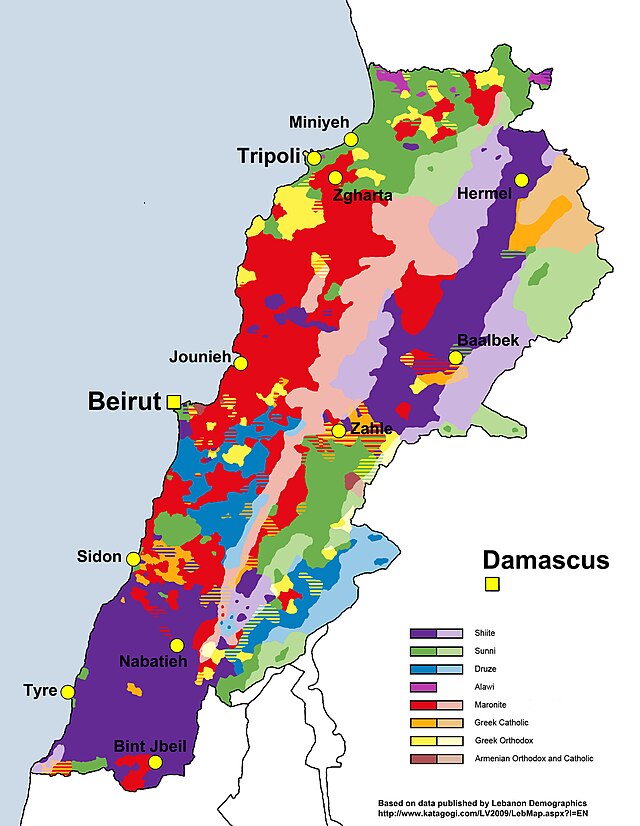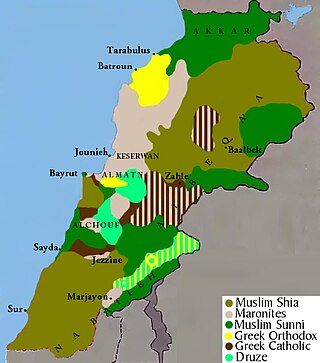Top Qs
Timeline
Chat
Perspective
Islam in Lebanon
From Wikipedia, the free encyclopedia
Remove ads
Islam has a long, continuous history in Lebanon. The majority of the Lebanese population in Lebanon is Muslim, although the precise percentage is difficult to ascertain. The Lebanese constitution officially guarantees freedom of religion for government-registered religions, including five denominations of Islam, although a blasphemy law and restrictions on religious groups that "disturb the public order" exist as well.[3] Under the Taif Agreement, Muslims are allocated proportional representation across multiple governmental positions.[3]
Although some sources might claim that Druze people are a part of Islam, they are a minority group that is very different from Islamic thought and its is a combination of all Abrahamic Religions as well as Greek Philosophy
Remove ads
History
This section needs expansion. You can help by adding to it. (March 2024) |
Demographics
Summarize
Perspective
It is difficult to obtain precise demographic information within Lebanon, as the country has not had an official census since 1932. In that census, Muslims amounted to 42% of the population (with slightly more Sunni than Shia Muslims), but Christians (primarily Maronites) composed a small majority of the population.[4] Lebanon was a French mandate between World War I and World War II, and was founded in part to serve as a home for Christians within West Asia.[10]
Demographic estimates since the 1932 census have found a significantly higher proportion of Muslims than the census did. This increase is not generally believed to be a result of population changes, but rather due to less biased estimation processes.[10][11]
Current demographic estimates generally agree that Muslims represent the majority of the Lebanese population, though estimates range from 60 to 70% of the Lebanese population. According to the May 2025 edition of the CIA World Factbook, the Muslim population is estimated to be 67.8%,[a] of which approximately 47% are Sunni, 47% are Shia, and the remainder are Alawite or Ismaili.[12] Pew Research estimated the 2020 proportion of Muslims in Lebanon in 2020 at 61.2%.[13] Statistics Lebanon, a non-governmental research firm, estimated that 69.3% of Lebanese people Muslims, with approximately 45% of these Muslims being Shia, 45% being Sunni, and 10% being Alawite or Ismaili.[3] A Central Intelligence Agency (CIA) study in 1985 put the numbers of Muslims at 68% of the population in 1985.[4]
The Druze are sometimes designated as one of the five Lebanese Muslim communities (Sunni, Shia, Druze, Alawi, and Ismaili),[14][15] even though most Druze do not identify as Muslims,[16][17][18][19][20] and they do not accept the five pillars of Islam.[21]
In Lebanon, the different Muslim sects are spread across distinct regions. Sunnis are mainly concentrated in West Beirut, Tripoli in the north, Sidon in the south, and parts of the Bekaa Valley such as Arsal. Shias are largely based in South Lebanon, particularly around Tyre, Nabatieh, and Bint Jbeil, as well as in the Bekaa Valley around Baalbek and Hermel, and in Beirut’s southern suburbs known as Dahieh. Alawites, who make up a very small community, are mostly found in the Jabal Mohsen neighborhood of Tripoli.
Distribution of Lebanese muslims in 2014 [22]
- Lebanese Sunni Muslims (49.7%)
- Lebanese Shia Muslims (48.9%)
- Alawites (1.43%)
Distribution of Lebanese muslims in 2022 [9]
- Lebanese Sunni Muslims (49.6%)
- Lebanese Shia Muslims (48.9%)
- Alawites (1.47%)
In 2014, according to *وقائع إنتخابية عن لبنان، حسب لوائح الناخبين الرسمية الصادرة عن وزارة الداخلية اللبنانية لسنة ٢٠١٤*,[23] Muslims made up 56.9% of registered voters aged 21 and above: 28.26% Sunnis, 27.83% Shias, and 0.81% Alawites. In 2022,[24] based on the registered voters aged 21+ for the elections, Muslims represented 56.83%: 28.21% Sunnis, 27.77% Shias, and 0.84% Alawites. The overall proportions remained very stable between 2014 and 2022, with only slight increases in all three groups.
Remove ads
Current political and religious issues
Summarize
Perspective
This section has multiple issues. Please help improve it or discuss these issues on the talk page. (Learn how and when to remove these messages)
|
Although Lebanon is officially a secular country, religious identity and religious leadership play significant roles for the Lebanese government. Religious groups must register with the Lebanese government, and citizens report their religious identity to the Ministry of Interior’s (MOI’s) Personal Status Directorate. The government considers the Druze a sect of Islam.[3] Religious identities play a critical role in maintaining the balance of power within the Lebanese government; the National Pact of 1943 guarantees that the Prime Minister must be a Sunnite, and the Speaker of Parliament must be a Shiite, and the President must be a Maronite Christian.[25] Under the National Pact, 45% of the governmental and parliamentary positions were reserved for Muslims. Since the Taif Agreement in 1990, this has been revised to a 50-50 split between Muslims and Christians.[11]
Family matters such as marriage, divorce and inheritance are still handled by the religious authorities representing a person's faith. Calls for civil marriage are unanimously rejected by the religious authorities but civil marriages conducted in another country are recognized by Lebanese civil authorities.[3]
Atheism is not recognized by the state. However, the Minister of the Interior Ziad Baroud made it possible in 2009 to have the religious sect removed from one’s Lebanese identity card. This does not, however, deny religious authorities complete control over civil family issues inside the country.[26][27]


Branches
Summarize
Perspective
Lebanese Muslims are divided into many branches like Shiites, Sunnis, Alawites, and Ismailis.
The Druze are sometimes considered a fifth branch of Islam for governmental purposes, despite significant religious differences between the faiths most don't identify as Muslims.[28][29][18][19][20]
Shia Islam
The Lebanese Shia Muslims are around 29%[30][31]-31%[3] of the total population. Twelvers are the predominant Shia group, followed by Alawites and Ismailis. The Speaker of Parliament is always a Shi'a Muslim, as it is the only high post that Shi'as are eligible for.[32][33][34][35] The Shiites are largely concentrated in northern and central Beqaa, Southern Lebanon, in south Beirut (southern parts of Greater Beirut).[36][37]
Sunni Islam
The Lebanese Sunni Muslims constitute around 27%[36]–29%[3] of the total population with the Hanafi and Shafiʽi madhhab being the predominant Sunni groups. Sunni notables traditionally held power in the Lebanese state together, and they are still the only ones eligible for the post of Prime Minister[38] Sunnis form the majority in west Beirut, Tripoli, Sidon, Central and Western Beqaa and hasbaya, ikleem al kharroub, Miniyeh, and Danniyeh districts, and Akkar in the north.[36]
Several large Sufi orders are active in the country, including the Naqshbandi and Qadiriyya tariqas.[39]
Druze
The Lebanese Druze constitute 5%[3] of the population and can be found primarily in Mount Lebanon and the Shouf District. Under the Lebanese political division (Parliament of Lebanon Seat Allocation) the Druze community is designated as one of the five Lebanese Muslim communities (Sunni, Shia, Druze, Alawi, and Ismaili).[14][15] Most Druze do not identify as Muslims.[28][29][18][19][20]
Remove ads
See also
Notes
- the estimate is 72.3% if Druze are included as Muslim
References
Wikiwand - on
Seamless Wikipedia browsing. On steroids.
Remove ads

